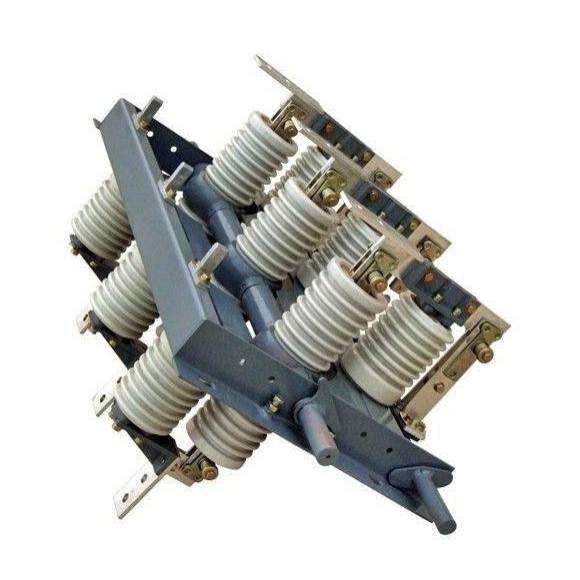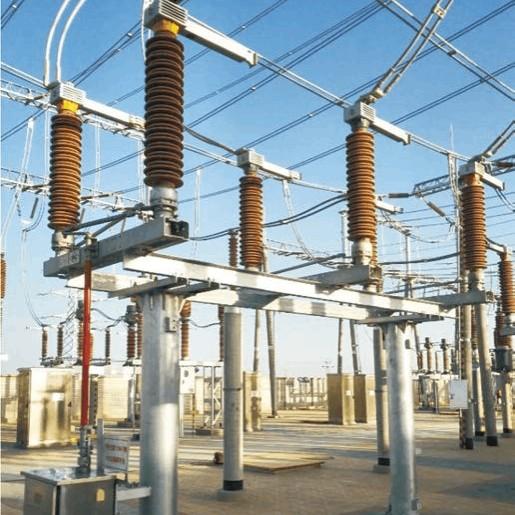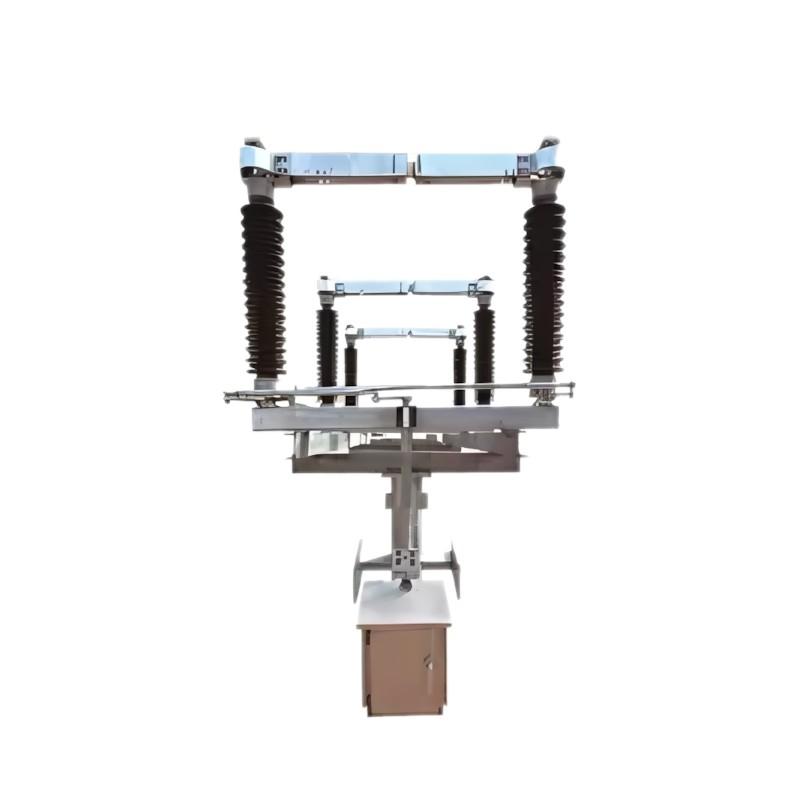1.Working Principle and Structural Features of GW4-126 Disconnector
The GW4-126 disconnector is suitable for AC 50/60 Hz power lines with a rated voltage of 110 kV. It is used to disconnect or connect high-voltage circuits under no-load conditions, enabling circuit switching, operational mode changes, and safe electrical isolation of busbars, circuit breakers, and other high-voltage equipment during maintenance. Disconnectors typically feature a clearly visible open point to ensure safe current interruption.
1.1 Working Principle of GW4-126 Disconnector
The GW4-126 disconnector operates via an operating mechanism that drives the contacts to open or close, thereby switching and isolating the circuit. Specifically, when it is necessary to interrupt or close current in a high-voltage circuit, the disconnector is employed. Structurally, it adopts a double-column horizontal gap design, with each set consisting of three independent single-pole disconnectors capable of switching circuit current.
During operation, the operating mechanism transmits force through linkages to the bearing seat, then transfers torque via insulators to the conductive arms, which rotate approximately 90° during opening/closing operations to achieve contact separation or engagement. Additionally, the GW4-126 disconnector uses an electric operating mechanism, allowing operators to drive the contact system via electric motor or manual crank. Moreover, the GW4-126 disconnector possesses high mechanical strength and electrical performance, enabling reliable operation under various environmental and operational conditions.
1.2 Structural Features of GW4-126 Disconnector
The structure of the GW4-126 disconnector includes a base, contact system, operating mechanism, and support frame. The base serves as the foundational component, providing overall stability. The contact system is the critical part, comprising the contact-side and finger-side components. Spring contacts in the conductive parts shall be made of pure copper with a grade no lower than T2.
Contact surfaces of contacts, conductive rods, and other mating areas shall be silver-plated, with a plating thickness of no less than 20 μm and hardness greater than 120 HV. Thus, the contact system of the GW4-126 disconnector exhibits excellent conductivity and mechanical strength. The operating mechanism drives the contact movement via manual crank or electric motor. The mechanism of the GW4-126 disconnector is simple and reliable, adaptable to diverse environments and operating conditions. The support frame fixes the disconnector in its designated position.

2.Current Research Status on Quality Control and Acceptance Standards for GW4-126 Disconnector Installation
Currently, there is limited research—both domestically and internationally—on quality control and acceptance standards specifically for GW4-126 disconnector installation. Existing studies mainly focus on three aspects:
Research on installation quality control standards for disconnectors globally. Standard-setting bodies such as the International Electrotechnical Commission (IEC) and China Electric Power Research Institute have developed a series of standards related to disconnector installation quality control, including installation specifications and acceptance criteria.
Case studies on disconnector installation quality control practices. Some power engineering companies and research institutions have conducted practical case studies, summarizing field experience from construction and acceptance processes to formulate practical guidelines and recommendations.
Technical research on disconnector installation quality control. Academic institutions and power utilities have investigated relevant technologies, such as installation processes, inspection methods, and quality control procedures, to enhance installation quality and efficiency.
As a key component of power systems, disconnectors must comply with relevant standards and requirements during installation to ensure safe and reliable operation. Therefore, further in-depth and comprehensive research on quality control and acceptance standards for GW4-126 disconnector installation remains necessary.
3.Quality Control Standards for GW4-126 Disconnector Installation
Potential issues and hazards may arise during disconnector installation, necessitating thorough analysis and implementation of corrective measures to ensure compliance with quality and acceptance standards. A common problem is non-compliance with technical requirements—for example, failure to follow correct installation procedures or use of improper tools and materials—which may result in malfunction or latent safety risks to personnel and equipment.
To address these issues, quality control standards for GW4-126 disconnector installation include: (1) criteria for judging conforming and non-conforming components, (2) quality control during the installation process, and (3) evaluation of installation quality.
3.1 Judgment Criteria for Conforming and Non-Conforming Components
(1) Requirements for conforming components:
Conforming components are those meeting quality control and acceptance standards during GW4-126 disconnector installation.
Appearance: Surfaces shall be smooth, free of scratches, abrasions, deformation, corrosion, cracks, bubbles, or impurities.
Dimensions: Must comply with design drawings regarding length, width, height, hole spacing, etc., with proper assembly clearances and accurate component alignment.
Materials: Shall meet relevant national or industry standards, exhibiting good mechanical, electrical, and corrosion-resistant properties. Materials must undergo appropriate treatment and testing to ensure reliability.
Markings: Product model, manufacturer, production date, and quality marks shall be clearly visible and compliant with standards.
Performance: Must satisfy mechanical (operating force, operation cycles, sensitivity) and electrical (rated voltage, rated current, insulation level, loop resistance) requirements. Components must pass rigorous performance tests to ensure functionality and service life.
(2) Judgment criteria for non-conforming components:
Non-conforming components fail to meet specified requirements. To identify them:
Conduct comprehensive inspections of all parts (appearance, dimensions, function, materials).
Isolate defective items and document findings.
Qualified personnel shall evaluate against established standards.
Upon confirmation as non-conforming, notify relevant departments immediately and implement repair or replacement to ensure final installation meets quality requirements.
3.2 Quality Control During GW4-126 Disconnector Installation
Quality control is crucial for reliable operation and extended service life. Key methods include:
Strict material inspection: Materials must comply with standards. Suppliers should be rigorously vetted, materials tested upon receipt, and traceable records maintained.
Strict installation and commissioning: Follow technical specifications precisely during assembly, wiring, and commissioning. Critical components (conductive circuits, operating mechanisms, transmission systems) require special inspection and adjustment.
Strict quality tracking and monitoring: Establish a robust tracking system to record and inspect each step. Analyze process and quality records to promptly identify and correct issues, ensuring traceability. Conduct periodic spot checks and evaluations to enhance quality management.
3.3 Evaluation of GW4-126 Disconnector Installation Quality
Installation quality must be evaluated against standards regarding functionality, safety, and reliability. The disconnector must reliably isolate and interrupt current to ensure personnel and equipment safety. Evaluation should also consider electromagnetic compatibility, durability, and maintainability.
4.Acceptance Standards for GW4-126 Disconnector Installation
Acceptance is a critical post-installation step to verify compliance with predetermined standards. Ambiguous or lenient acceptance criteria can introduce subjectivity, leading to inconsistent judgments and compromised quality control. To ensure effective quality control and acceptance, standards must be established in three areas: safety, equipment performance, and materials.
4.1 Safety Acceptance Standards
Safety is paramount. Standards shall cover:
Electrical connections: Must be secure and reliable, preventing poor contact or loosening.
Grounding protection: Must comply with national/industry standards to ensure safe fault grounding.
Operational safety: Clear, accurate external markings for status identification; operating handles shall provide comfortable grip and moderate force for easy manual operation.
Visual inspection: Check main body, accessories, linkages, and terminals for deformation, cracks, or damage; ensure all connections are tight and terminals secure.
Environmental adaptability and IP rating: The disconnector must operate reliably under varying temperature, humidity, and corrosive conditions. Required ingress protection (IP) ratings for dust, water, and corrosion resistance must be clearly specified and met.
4.2 Equipment Performance Acceptance Standards
Performance standards ensure the disconnector operates as designed:
Contact electrical performance: Test contact resistance, arc erosion resistance, and dielectric strength.
Opening/closing performance: Verify speed, stroke distance, and three-phase synchronism.
Insulation performance: Measure insulation resistance, withstand voltage, and flame retardancy of insulation materials.
Operating performance: Assess operating force, number of operations, and operational stability.
4.3 Material Acceptance Standards
Acceptance shall include review of documentation: design drawings, product manuals, quality certificates, and installation guides—to confirm compliance with national and industry standards. Inspectors must record all inspection, test, and evaluation results, compare them against applicable standards, and implement corrective actions for any non-conformities to ensure installation meets quality expectations.
5.Conclusion
This paper establishes quality control and acceptance standards for GW4-126 disconnector installation. Regarding quality control, requirements are defined for conforming components, handling of non-conforming items, process control, and quality evaluation. For acceptance, safety, performance, and material standards are formulated to ensure the disconnector operates safely and effectively under normal conditions. However, unresolved issues remain requiring further study. Future research should explore optimization of quality control methodologies. Current approaches primarily focus on technical specifications and on-site acceptance; more effective and reliable methods may exist. Thus, future work should analyze existing practices and develop optimal quality control strategies tailored to disconnector installation.


























